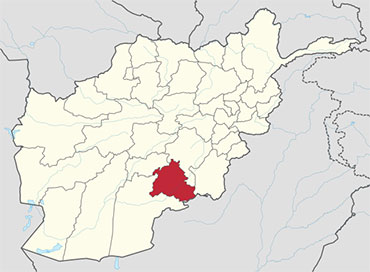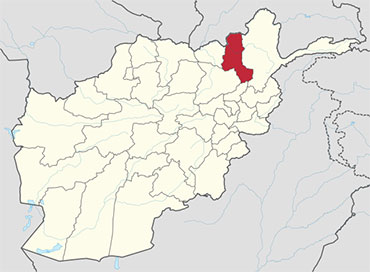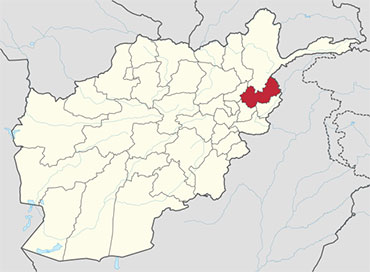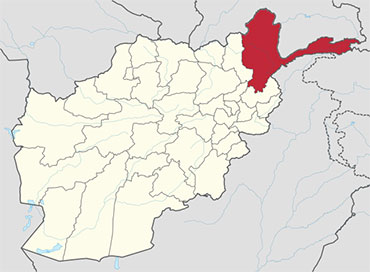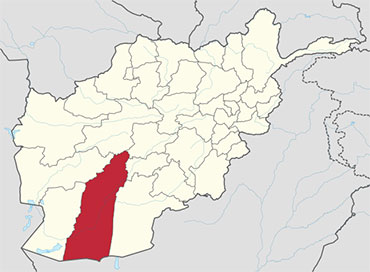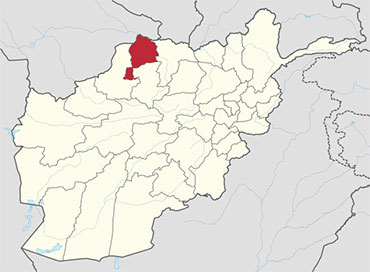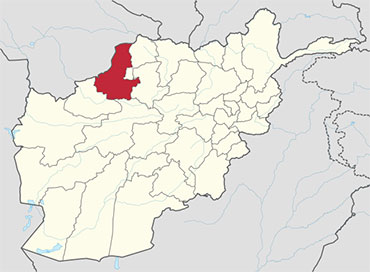 Faryab is one of the thirty-four provinces of Afghanistan, which is located in the north of the country bordering neighboring Turkmenistan. It has a population of about 948,000, which is multi-ethnic and mostly a tribal society. The province encompasses 15 districts and over 1,000 villages. The capital of Faryab province is Maymana.
Faryab is one of the thirty-four provinces of Afghanistan, which is located in the north of the country bordering neighboring Turkmenistan. It has a population of about 948,000, which is multi-ethnic and mostly a tribal society. The province encompasses 15 districts and over 1,000 villages. The capital of Faryab province is Maymana.
History
Faryab is a Persian word meaning “irrigated land”. British officials were later to name the area including Faryab and the surrounding provinces ‘Afghan Turkestan’, although the area has at times also been called Khurasan, not to be confused with the use of that name for Persia. The modern province is named after a town that was founded by the Sassanids and later destroyed by the invading Mongols in 1220. It is the home town to the famed Islamic philosopher, al-Farabi, per the biographer Ibn al-Nadim.
The history of settlement in Faryab is ancient and comprises layer upon layer of occupation. At times, it was a melting pot within which a host of cultures have merged into a non-conflictual whole or at least peaceable coexistence. Maymana (the small capital city of the district) and Andkhui actually entered written history 2,500 years ago when Jews arrived and settled in 586 BC, fleeing the destruction of Jerusalem by Nebuchadnezzar. The area was under Persian control at the time, which later gave way to Greek rule following the conquest by Alexander the Great in 326 BC. Persian dominance was restored from the 3rd to 7th century AD.
The pre-Islamic period ended with the conquest of northern Afghanistan by Arab Muslims (651-661 AD). The area “turned into a vast battlefield as the two great Arab and Persian cultures battled for not only political and geographical supremacy but ideological supremacy.” As a result, centuries of Zoroastrianism, Buddhism, Nestorian Christianity and indigenous pagan cults were swept away. Various Islamic dynasties dominated Faryab and surrounds since then.
The history of Faryab was greatly altered yet again in the 11th century, this time with the invasion of Genghis Khan and his “Mongol Horde” from 1220 AD. As he moved into the area from the north, cities and towns including Maymana were razed, populations massacred, grain, fields and livestock stolen or burnt and ancient irrigation systems obliterated. This Turco- Mongol rule lasted 500 years; this covered the modern provinces of Faryab, Jauzjan, Balkh, Samangan, Kunduz and Baghlan. Control by the descendants of Genghis Khan (Chingizids) stemmed from the alternating capitals of Bukhara or Samarkand north of the Amu Darya (the Oxus) River. They ruled in a decentralised manner, however, allowing local amirs in Maymana and elsewhere considerable autonomy, a legacy which was to last until the end of the 19th century.
Uzbek occupation of the area began within the Chingizid period. In 1500, Uzbek princes, also known as Khanate of Bukhara, themselves a Turco-Mongol product, swept across the Amu Darya, reaching Faryab and related areas around 1505. They joined a substantial and largely pastoral Arab population and ruled the area until the mid-18th century.
It was conquered by Ahmad Shah Durrani in or about 1722 and became part of the Durrani Empire, which formed to the modern state of Afghanistan. His control of the north was uncertain and following his death in 1747, local Uzbek amirs largely reasserted their autonomy with weak Afghan (Pushtun) dominance from the south. About 1.5 centuries later, Amir Abdul-Rahman, supported by the British policy to create a buffer zone between British India and Russia, managed to thoroughly annex the north back into Afghanistan. The path towards this was mixed, the important principality of Maymana being the last of the Uzbek Khanates to resist (1893/94). The area was untouched by the British during the three Anglo-Afghan wars that were fought in the 19th and 20th centuries. Faryab become a province in 1964. From the administrative reforms of the 1930s until then it was known as Maymana and was a sub-province of Balkh Province, which had its headquarters in Mazar-i-Sharif.
During the 1990s Afghan Civil War (early 90s and late 90s, the front line between Taliban and opposition forces often fell between Badghis and Faryab provinces in the mid-1990s. Former Tajik warlord Ismail Khan also fled to Faryab to reconstitute his forces following the Taliban takeover of Herat Province, but was betrayed by Uzbek warlord Abdul Malik Pahlawan.
A market street in Maymana
In May 1997, Abdul Malik Pahlawan raised the Taliban flag over the capital of Maimana, switching sides and initiating a renewed Taliban offensive from the west. Following a series of changing allegiances and falling out with Malik, the Taliban withdrew from the area, but in 1998 a contingent of 8,000 Taliban troops pressed through Faryab, seizing Abdul Rashid Dostum’s headquarters in Sheberghan, in neighboring Jowzjan province.
Faryab province has been one of the more peaceful areas in Afghanistan since the fall of the Taliban government in late 2001. Recent development projects in the province have focused on expanding the agricultural potential of the province, in particular the re-forestation of areas of the province that were denuded in the recent past.
Provincial Reconstruction Team (PRT) members of the Norwegian Army on a patrol in Faryab Province (December 2009)
It was reported in 2006 that Abdul Malik Pahlawan’s Freedom Party of Afghanistan still maintained an armed militant wing, which was contributing to instability in province. The Afghan National Security Forces (ANFS) began expanding and slowly took over control. The Afghanistan-Turkmenistan border is maintained by the Afghan Border Police (ABP) while law and order for the rest of the province is provided by the NATO-trained Afghan National Police (ANP).
At the province is a Provincial Reconstruction Team (PRT), which is led by Norway. The Norwegian PRT has its base at Maymana and has also been given the responsibility for the Ghormach District which used to be in neighboring Badghis but is now, as of December 2008, part of Faryab Province.
Afghanistan signed a deal with China National Petroleum Corporation (CNPC) for the development of oil blocks in the Amu Darya basin, a project expected to earn billions of dollars over two decades; the deal covers drilling and a refinery in the northern provinces of Sar-e Pol and Faryab, and is the first international oil production agreement entered into by the Afghan government for several decades. CNPC began Afghan oil production in October 2012, and in the same month a huge gas reserves were discovered in the Andkhoy District of Faryab province.
Economy
Agriculture and animal husbandry are the primary economic activities in the province however Faryab is renowned for its carpets, knitted as well as woven Kilims, which are traditionally a female-dominated handicraft. The province has a disputed amount of natural gas reserves but levels of exploitation are low.
There is a salt mine in Dowlat Abad district and some marble resources (said to owned by Abdul Rashid Dostum) and there are also pistachio forests which produce Pistacia vera which are renowned for their color and intense flavor.
Healthcare
The percentage of households with clean drinking water increased from 23% in 2005 to 24% in 2011. The percentage of births attended to by a skilled birth attendant increased from 2% in 2005 to 16% in 2011.
Demographics
The population of Faryab province is about 948,000, which is multi-ethnic and mostly a tribal society. The main ethnic groups living in Faryab Province are Uzbek and Tajik, followed by Pashtun, Turkmen, and Hazara. Occasional ethnic clashes are reported between Uzbeks and Pashtuns.
The Uzbek people population (53%) represent the majority in Faryab, followed by Tajiks (ca. 27%-30%). Others are Pashtuns (13%) and Turkmen people (ca. 4%-6%). However, the number of Pashtuns in Faryab is decreasing drastically like elsewhere in northern Afghanistan because many non-Pashtuns still take revenge for the crimes of Taliban Pashtuns against non-Pashtuns.
Dari (Persian) and Uzbeki are the main languages spoken in and around the province. All the inhabitants follow Islam, with Sunnis making up the majority while Shiites (Shias) make up the minority. The Shias are mainly the ethnic Hazaras.
Districts
Faryab province is divided in to 15 districts.
| Province | Population | Area |
|---|---|---|
| Almar | 120,000 | 1,525 km2 |
| Andkhoy | 41,656 | 381 km2 |
| Bilchiragh | 41,706 | 1,189 km2 |
| Dawlat Abad | 57,876 | 2,598 km2 |
| Ghormach | ||
| Gurzaiwan | 72,497 | 1,875 km2 |
| Khan Char Bagh | 70,000 | 1,056 km2 |
| Khaja Sahib Posh | 55,000 | 800 km2 |
| Kohistan | 53,616 | 2,254 km2 |
| Maymana | 75,900 | |
| Pashtun Kot | 300,000 | 4,000 km2 |
| Qaramqol | 98,229 | 2,192 km2 |
| Qaysar | 237000 | 2,502 km2 |
| Qurghan | 27,116 | 797 km2 |
| Shirin Tagab | 141,642 | 3,500 km2 |
